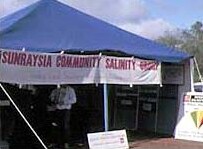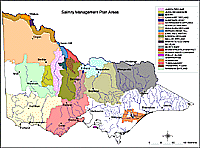Salt Action-Joint Action
Dryland Salinity | Irrigated Salinity | Urban Salinity | Salinity Indicator Plants
In May 1988, the Victorian Government released the Victorian Salinity Strategy, Salt Action-Joint Action, for tackling the growing salinity problems in the state. This strategy set out a systematic program for developing community-led Salinity Management Plans (SMPs) for salt affected regions.
The overall goal of the Victorian Salinity Strategy, was to manage the salinity of land and water resources throughout Victoria in order to maintain, and where feasible, to improve the social well-being of communities and the environmental quality and productive capacity of the regions.
Specific state-wide salinity control objectives outlined in Salt Action – Joint Action were:
- to stabilise watertables at harmless levels in irrigation areas with good quality groundwater
- to significantly retard rising groundwater by control of groundwater recharge, and where necessary to adapt to higher saline conditions in irrigation areas with saline groundwater
- to significantly reduce accessions to the groundwater systems and to substantially improve salinity problems associated with localised groundwater systems
- to protect, and where appropriate, rehabilitate high value wetlands and other significant environmental features.
 Community consultation ensured the success of the Sunraysia Community Working Group's Salinity Management Plan in the early 1990s Photo: Steve Page |  This map shows the location of the 22 government endorsed Salinity Management Plans (SMPs) developed in the 1990’s. |
Salinity Managent plans included:
- an overview of the causes and effects of salinity, locally
- an assessment of the economic, social and environmental effects of various alternative salinity control measures, including a "do nothing" option
- preferred measures and implementation targets
- cost-sharing arrangements
- incentives and sanctions to ensure adoption of the plan
- arrangements governing the discharge of salt to the River Murray (where relevant)
- descriptions and assessments of wetlands likely to be affected, by salinity control measures, and of the effects of the measures
- responsibilities for implementing and reviewing the plan.
In the year 2000, the government reviewed the salinity plans and produced revisions known as the Salinity Management Framework.
Currently second generation Salinity Management Plans have superseded the original plans and for further information on these contact your local Catchment Management Authority [external link].


